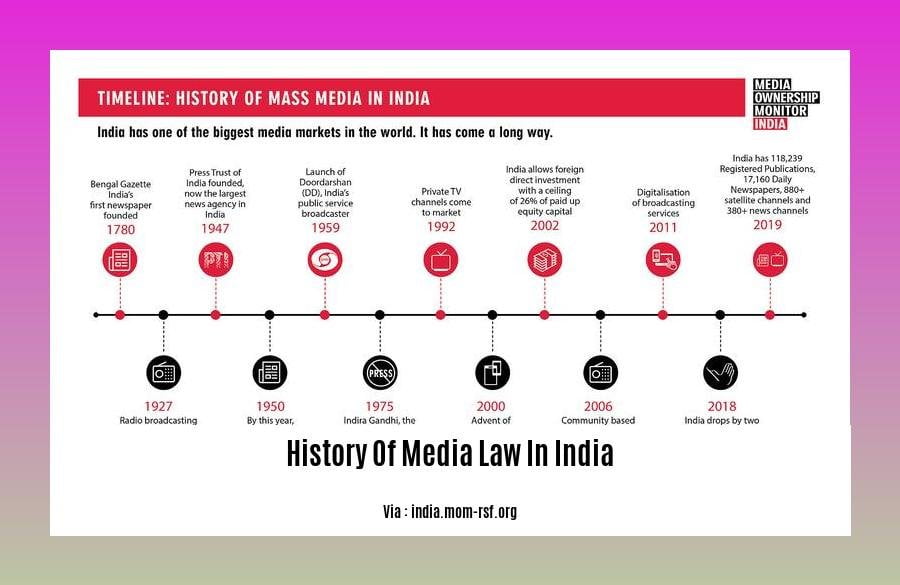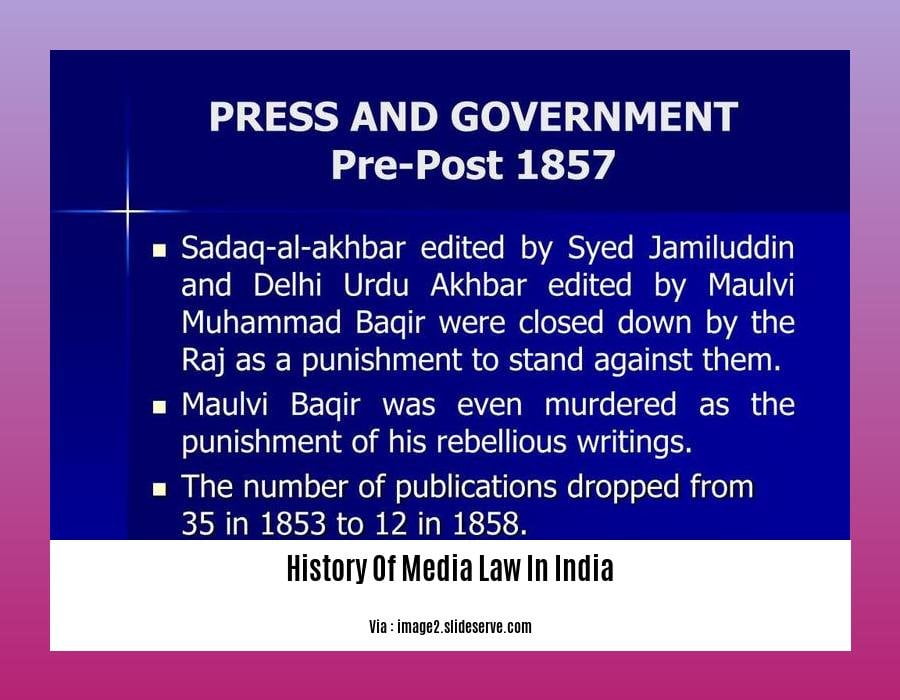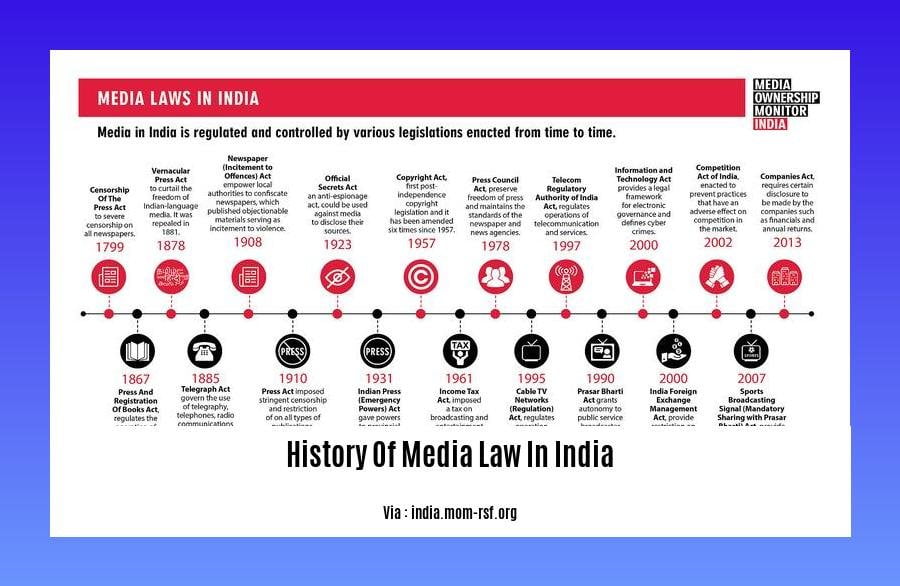In the realm of Indian jurisprudence, the history of media law stands as a fascinating narrative of evolving societal norms, technological advancements, and legal frameworks that have shaped the contours of free speech, expression, and the dissemination of information. Join us on a journey through time to explore the milestones, landmark cases, and key developments that have left an indelible mark on the legal landscape governing media and communication in India, aptly titled [A Journey Through Time: The History of Media Law in India].
Key Takeaways:
Colonial Era: The history of media law in India dates back to the colonial rule under the British when pre-censorship was imposed on the newspaper industry with the Press Regulations of 1799.
Pre-Independence: During this period, several laws were enacted to control the press, including the Licensing Act of 1857 and the Vernacular Press Act of 1878.
Post-Independence: After India’s independence, the Press Commission was established to review and recommend reforms to media laws, leading to the enactment of the Press Council Act of 1978 and the establishment of the Press Council of India.
Constitutional Guarantees: The Constitution of India guarantees freedom of speech and expression as a fundamental right, subject to reasonable restrictions for national security, public order, and morality.
Judicial Interpretation: The Supreme Court of India has played a crucial role in interpreting and upholding the freedom of the press through landmark judgments.
History of Media Law in India

The history of media law in India is a complex and fascinating one, dating back to the colonial era. The legal framework governing the media industry has evolved significantly over the years, reflecting the country’s changing political and social landscape.
Early Regulations
The first major piece of media legislation in India was the Press Regulations of 1799, which imposed pre-censorship on the newspaper industry. This law was followed by a series of other restrictive measures, including the Licensing Act of 1857 and the Vernacular Press Act of 1878. These laws were designed to control and suppress dissent, and they had a chilling effect on the freedom of the press.
Post-Independence Era
After India gained independence in 1947, the government established the Press Commission to review and recommend reforms to the existing media laws. The Commission’s recommendations led to the enactment of the Press Council Act of 1978, which established the Press Council of India as a self-regulatory body for the print media.
The Press Council has played an important role in upholding the freedom of the press in India. It has issued several guidelines and advisories to the media, and it has also adjudicated complaints against journalists and newspapers.
The Role of the Supreme Court
The Supreme Court of India has played a crucial role in interpreting and upholding the freedom of the press in India. In a number of landmark judgments, the Court has held that freedom of speech and expression is a fundamental right guaranteed by the Constitution of India. However, this right is subject to reasonable restrictions in the interests of national security, public order, and morality.
Challenges to the Media
The media in India faces a number of challenges today, including:
- Government censorship: The government continues to exercise some control over the media, and it has been known to use its power to suppress dissent.
- Political pressure: The media is often subject to political pressure from both the government and opposition parties. This pressure can lead to self-censorship and a lack of critical reporting.
- Economic pressures: The media is also facing economic challenges, as advertising revenues have declined in recent years. This has led to job losses and a decline in the quality of journalism.
Conclusion
The history of media law in India is a story of struggle and progress. The media has played a vital role in India’s democracy, and it continues to be an important force for change. However, the media faces a number of challenges today, and it is important to ensure that it remains free and independent.
Delve into the rich tapestry of mass media in India through this comprehensive exploration of its history, tracing its evolution from ancient roots to modern-day marvels. history of mass media in india
Journey through the annals of Moroccan history, exploring its pivotal moments and key turning points in this meticulously crafted timeline. history of morocco timeline
Discover the fascinating history of Mountain Province, uncovering its unique cultural heritage, dramatic landscapes, and resilient spirit. history of mountain province
Post-Independence Media Law Framework
India’s journey post-independence was marked by a paradigm shift in media law. It was time to redefine the narrative, moving from colonial constraints to a framework that echoed the nation’s democratic ethos. Let’s dive into this transformative era!
Unleashing the Spirit of Freedom
The shackles of colonial rule were cast aside, replaced by a profound commitment to freedom of speech and expression. The Indian Constitution, our guiding beacon, enshrined this fundamental right, recognizing its pivotal role in a vibrant democracy.
Balancing Act: Reasonable Restrictions
While upholding this cherished freedom, the Constitution acknowledged the need for reasonable restrictions in certain instances. National security, public order, and morality emerged as legitimate grounds for limiting expression when deemed necessary.
The Press Council: A Bastion of Self-Regulation
In 1978, the Press Council Act ushered in a new era of self-regulation for the print media. The Press Council of India, an independent body, was entrusted with the responsibility of upholding ethical standards and protecting the freedom of the press.
Landmark Judgments: Shaping the Discourse
The Supreme Court of India played a pivotal role in shaping the media landscape through its landmark judgments. Time and again, the apex court reaffirmed the significance of press freedom, recognizing it as a cornerstone of a democratic society.
Challenges Amidst Progress: A Reality Check
Despite the progressive strides, the Indian media has faced formidable challenges. Government censorship, political pressure, and economic constraints have often cast a shadow, threatening to stifle independent journalism.
Key Takeaways:
The post-independence era marked a paradigm shift in media law, moving from colonial constraints to a framework rooted in democratic principles.
The Indian Constitution enshrined freedom of speech and expression as a fundamental right, while acknowledging the need for reasonable restrictions in certain circumstances.
The Press Council of India, established in 1978, serves as a self-regulatory body for the print media, upholding ethical standards and safeguarding press freedom.
The Supreme Court of India has played a crucial role in shaping the media landscape through its landmark judgments, reinforcing the importance of press freedom in a democratic society.
The media in India has faced significant challenges, including government censorship, political pressure, and economic constraints, which have the potential to undermine independent journalism.
Citations:
History of Media Law in India
Landmark Judgments on Freedom of Speech and Expression

Imagine a world where you couldn’t share your thoughts, express your opinions, or question the powers that be. That’s the world our forefathers fought to liberate us from, and our freedom of speech is a cornerstone of that liberty.
Over the years, several landmark judgments have shaped the landscape of free speech in India, and in this article, we’ll take a journey through the most significant ones.
1. Romesh Thappar v. State of Madras (1950)
In this landmark case, the Supreme Court held that the freedom of speech and expression under Article 19(1)(a) of the Indian Constitution includes the right to criticize the government and its policies.
This judgment established that the government cannot arbitrarily restrict free speech on the grounds of public order or national security.
2. Bennett Coleman & Co. v. Union of India (1973)
Popularly known as the “Newspaper Case,” this judgment solidified the freedom of the press as an essential part of the freedom of speech and expression. The Supreme Court ruled that the press has the right to criticize the government and its policies without fear of reprisal.
Key Takeaways:
- Indian media history is a blend of colonial influence and post-independence evolution.
- Regulations like the Press Acts aimed to stifle dissent during British rule.
- The freedom struggle saw newspapers mobilizing public opinion, facing government crackdowns.
- Post-independence, the Constitution enshrined freedom of speech but with reasonable restrictions.
- Press Council of India was formed as a self-regulatory body for ethical journalism.
- The Emergency period brought censorship and restrictions on the press.
- The Information Technology Act of 2000 regulates online content and communications.
- Digital media poses new challenges, with laws like the IT Act addressing online content regulation.
Sources:
- The History of Media Law in India
- Landmark Judgments on Freedom of Speech and Expression in India
Contemporary Challenges and Future Prospects
The media landscape in India has undergone a sea of change in recent years, with the advent of digital technologies and the rise of social media. These developments have posed new challenges to the existing legal framework governing the media, and have raised important questions about the future of media law in India.
Challenges:
Fake News and Misinformation: The ease with which false and misleading information can be disseminated online has created a major challenge for the media industry. It has become increasingly difficult for audiences to distinguish between credible and unreliable sources of information, leading to a decline in trust in the media.
Hate Speech and Online Abuse: The anonymity of the internet has emboldened some individuals to engage in hate speech and online abuse, particularly on social media platforms. This has created a hostile environment for journalists and other media professionals, and has had a chilling effect on freedom of expression.
Government Regulation: The government has also played a role in regulating the media in the digital age. The Information Technology Act of 2000 and the Information Technology (Intermediary Guidelines and Digital Media Ethics Code) Rules of 2021 have given the government wide-ranging powers to regulate online content and to take action against intermediaries such as social media platforms. While these regulations are aimed at protecting users from harmful content, they have also raised concerns about freedom of expression and the potential for censorship.
Prospects:
Despite the challenges, the future of media law in India looks promising. The Indian judiciary has played a crucial role in upholding freedom of expression and protecting the rights of journalists. Landmark judgments such as the Shreya Singhal v. Union of India (2015) and the Anuradha Bhasin v. Union of India (2020) cases have limited the government’s ability to censor online content and have affirmed the right to freedom of speech and expression.
Self-Regulation: The media industry is also taking steps to self-regulate and to address the challenges posed by the digital age. The News Broadcasters Association (NBA) and the Indian Broadcasting Foundation (IBF) have established self-regulatory codes that set standards for ethical journalism and responsible broadcasting.
Media Literacy: Media literacy initiatives can empower audiences to critically evaluate information and to distinguish between credible and unreliable sources. By promoting media literacy, it is possible to combat the spread of fake news and misinformation and to build trust in the media.
Technology and Innovation: Technological advancements can also be harnessed to address the challenges facing the media industry. For example, artificial intelligence (AI) can be used to detect and remove harmful content from online platforms, and blockchain technology can be used to create a more transparent and accountable media ecosystem.
Key Takeaways:
The rise of digital media and social media has created new challenges for media law in India.
Fake news, hate speech, and government regulation are among the key challenges facing the media industry.
The Indian judiciary has played a crucial role in upholding freedom of expression and protecting the rights of journalists.
The media industry is taking steps to self-regulate and to address the challenges posed by the digital age.
Media literacy, technology, and innovation can all play a role in shaping the future of media law in India.
References:
Media Law in India: Challenges and the Way Forward
FAQ
Q1: What were the key features of media law during the colonial era in India?
A1: During the colonial era, media law in India was characterized by strict censorship and control by the British government. The Press Regulations of 1799 imposed pre-censorship on the newspaper industry, and several laws such as the Licensing Act of 1857 and the Vernacular Press Act of 1878 further restricted the freedom of the press.
Q2: How did the Indian independence movement influence the development of media law in India?
A2: The Indian independence movement played a significant role in shaping media law in India. Many newspapers and publications were established during this period to mobilize public opinion and support for the freedom struggle, leading to a clash with the colonial government’s censorship policies.
Q3: What were the key provisions of the Indian Constitution regarding freedom of speech and expression?
A3: The Indian Constitution, adopted after independence, guaranteed freedom of speech and expression as a fundamental right under Article 19(1)(a). However, this right was subject to reasonable restrictions in the interests of national security, public order, and morality.
Q4: What role did the Supreme Court of India play in interpreting media law?
A4: The Supreme Court of India played a crucial role in interpreting the constitutional provisions on freedom of speech and expression in the context of media law. Landmark judgments such as Bennett Coleman and Co. v. Union of India (1973) and Romesh Thappar v. State of Madras (1950) established the importance of press freedom in a democracy and set precedents for protecting freedom of expression in India.
Q5: How has the rise of digital media and the internet impacted media law in India?
A5: The emergence of digital media and the internet in recent years has brought new challenges to media law in India. The Information Technology Act of 2000 was enacted to regulate online content and communications, including provisions to prevent the publication of “obscene” or “defamatory” content, as well as to protect intellectual property rights.
















